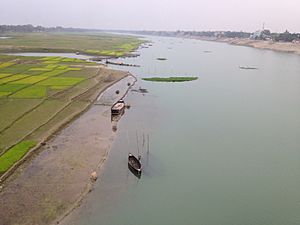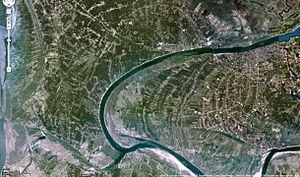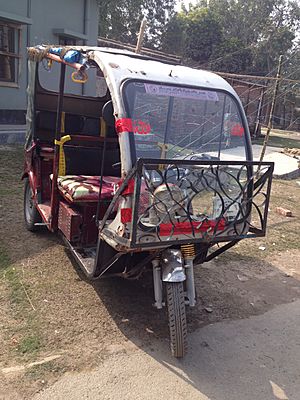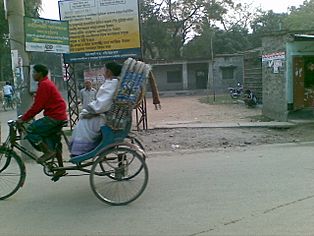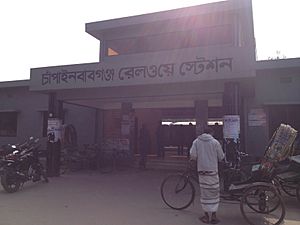Chapai Nawabganj District facts for kids
Quick facts for kids
Chapainawabganj
চাঁপাইনবাবগঞ্জ
|
|
|---|---|
| Chapainawabganj District | |

Chapainawabganj Landmarks (Clockwise from top): Gono kabar (mass grave), Sona Mosque (side view), Liberation War Statue, Tohakhana Mosque, Captain Jahangir bridge, mangoes, Sona Mosque
|
|
| Nickname(s):
Nobabganj
|
|
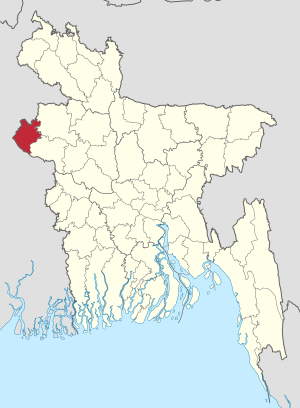
Location of Chapai Nawabganj District in Bangladesh
|
|
| Country | |
| Division | Rajshahi Division |
| Established | 1984 CE |
| Area | |
| • Total | 1,703 km2 (658 sq mi) |
| Population
(2022)
|
|
| • Total | 1,835,527 |
| • Density | 1,077.8/km2 (2,791.5/sq mi) |
| Demonym(s) | Chapainawabganji, Nobabgonji, Rajshahiyo |
| Time zone | UTC+06:00 (BST) |
| Postal code |
6300
|
| HDI (2019) | 0.642 medium · 6th of 21 |
Chapainawabganj (Bengali: চাঁপাইনবাবগঞ্জ) is a district in the north-western part of Bangladesh. It is part of the Rajshahi Division. This area was once a sub-division of the Malda district in the Bengal Province. To the north and west, Chapainawabganj borders the Malda and Murshidabad districts of India. To the east, it borders Naogaon District, and to the south-east, Rajshahi District.
Contents
History of Chapainawabganj
Chapainawabganj was once part of the ancient city of Gour, which was a capital of Bengal. This area was important for trade and strategy because it was located where the Mahananda and Ganges rivers met. Because of its importance, a town called Nowabganj was founded by Alivardi Khan. This town later became known as Nawabganj. Until 1947, Nawabganj was a small administrative area under the Malda district in India.
This region has seen many different empires rise and fall. Ancient texts mention a city called Gourpura, which is believed to be the city of Gouda. Its ruins are found in this district. Gour and Pandua were capital cities of Bengal in ancient and medieval times.
After the Gupta Empire, King Sasanka ruled independently in the early 7th century. From the 8th to the 11th century, the Pala Empire ruled Bengal. Their kings followed Buddhism. During their time, the Jagadalla Vihara (a large monastery) became famous. The Pala Dynasty was followed by the Sena Empire. The Sena rulers were Hindus. Gour was known as Lakshmanabati during the time of Lakshman Sen. The Sena kings ruled until Bakhtiyar Khilji conquered Bengal in 1204 AD. After that, Muslim rule lasted for about 500 years.
The British rule began after Sirajuddaulah was defeated by Lord Clive in the battle of Plassey in 1757. In 1813, the Malda district was formed from parts of other districts. In August 1947, when India was divided, it was unclear if Malda would be part of India or Pakistan. For a few days, the district was under an East Pakistan official. But on August 17, 1947, it became part of West Bengal, India. Five smaller areas (thanas) from Malda were given to Pakistan. These areas later formed Chapainawabganj district under Rajshahi district.
Geography of Chapainawabganj
Location and Landscape
Chapainawabganj is the westernmost district of Bangladesh. To its east are Rajshahi and Naogaon. To its north and west, it borders the Malda district of West Bengal, India. The Padma (Ganges) and parts of Malda and Murshidabad districts of West Bengal (India) are on its western and southern sides. Chapainawabganj is famous as one of Bangladesh's "mango cities."
The district covers an area of about 1702.55 square kilometers. Many rivers flow through this area, including the Ganges and Mahananda. Most of the land is flat, with many small ponds. However, the landscape has changed recently due to erosion from the Padma River. This erosion has created large sandy areas, almost like a small desert.
Land Types
Chapainawabganj has two main types of land based on soil formation:
Borendra Area
The eastern part of the Mahananda River is known as the Borendra area. This is an ancient and well-known region. It was formed during the creation of the Bengal delta. Chapainawabganj Sadar, parts of Gomostapur Upazila, and Nachol are in the Borendra area. The main crop grown here is rice.
Diyar Area
The region near the Padma River is called Diyar. This area was formed by the river changing its path over time. The soil here is very fertile, allowing farmers to grow different crops multiple times a year. Rice, wheat, and melons are common crops. The most famous corn grown here is Kalai. Mango orchards are also growing quickly in this area. In the past, this region was known for growing indigo and silk.
Rivers and Waterways
Chapainawabganj is home to several important rivers.
Padma River
The Ganges river starts in the Himalayas and flows through India. It enters Bangladesh at Shibganj and is then called the Padma. The Farakka Barrage, built upstream, has reduced the water level of the Padma. However, during the rainy season, the river can still flood nearby areas.
Mahananda River
The Mahananda River enters the district through Bholahat Upazila. It flows through the district and eventually joins the Padma River in Godagari, Rajshahi. Chapainawabganj town is located on the bank of this river, and the river plays a big role in the district's economy.
Pagla River
The Pagla River also flows from India into Bangladesh in this district. After flowing for a short distance, it joins the Mahananda River.
Punarbhaba River
The Punarbhaba River flows through the Dinajpur and Naogaon districts of Bangladesh before entering Chapainawabganj.
Climate
Chapainawabganj has a tropical climate with wet and dry seasons. The weather is usually marked by monsoons, high temperatures, and moderate rainfall. The hot season starts in early March and lasts until mid-July. The highest temperatures are in April, May, June, and July. The coolest month is January, with temperatures around 7 to 16 degrees Celsius (45 to 61 degrees Fahrenheit). Most of the rain falls during the monsoon months. The district gets about 1448 millimeters (57 inches) of rain each year.
Population and People
In 2022, Chapainawabganj District had a population of 1,835,527 people. About 25.5% of these people lived in urban areas. The population density was 1,078 people per square kilometer. For people aged 7 and over, the literacy rate (meaning they can read and write) was 71.9%.
Religions
Most people in Chapainawabganj District are Muslims, making up about 95.36% of the population in 2011. Hindus make up about 4.04%. There are also small numbers of people who follow other religions.
Education
Chapainawabganj has one university, the Exim Bank Agricultural University Bangladesh (EBAUB). It was started in 2013 to offer education in agriculture. It also has programs in Agricultural Economics, Business Administration, and Law. This university, along with Nawabganj Govt. College and Shah Neyamotullah College, are important educational places in the district.
Some other notable colleges in Chapainawabganj District include:
- Adina Fazlul Haque Govt. College
- Nawabganj Govt.College
- Chapainawabganj Polytechnic Institute
- Rahanpur Homoeopathic Medical College
- Nawabganj City College
- Shibganj Mohila Degree College
- Ranihati Degree College
- Sara Bangla A K Fojlol Haqe College
- Shibgang Boys College
- Namoshankarbati Degree College
Economy
The economy of Chapainawabganj is mostly based on agriculture. The district has very fertile land and good irrigation. Many rivers flow through the district, so many people also work in fishing.
Chapainawabganj is known as the "mango capital" of Bangladesh. Mangoes are the main product that supports the district's economy. Most of the land is covered with mango orchards, where many different kinds of mangoes are grown. The areas of Shibganj, Bholahat, and Gamostapur Upazilas are especially important for mango production.
Culture
Gombhira gaan is a type of folk song that is very popular in this district. These songs often use funny dialogues, songs, dances, and jokes to talk about current social problems. Gombhira is a big part of cultural celebrations in Chapainawabganj.
The people of Chapainawabganj speak the Bangla language, but they have their own special way of speaking. Their dialect has different tones and words compared to standard Bangla.
Religion and Places of Worship
Chapainawabganj district has many places of worship. There are 1987 mosques, 474 temples, 56 Buddhist temples, and 28 churches. Famous mosques include the Chotto Sona Mosque and the 15th-century Darashbari Mosque. Jora Math is a well-known Buddhist monastery, and Naoda Stupa is a Buddhist monument.
Places to Visit
Choto Sona Mosque
The Chhota Sona Masjid, or Sona Mosque, is a beautiful old building from the Sultanate period. It is located in Gaur, Chapainawabganj. It was built by Wali Muhammad during the time of Sultan Alauddin Husain Shah (1493–1519). The mosque originally had 15 gold-covered domes, which is how it got its name, "Sona" meaning gold. The brave martyr Birsrestha Captain Mohiuddin Jahangir is buried near this mosque.
Administration
Chapainawabganj district is divided into five smaller administrative areas called Upazilas:
- Bholahat Upazila
- Gomastapur Upazila
- Nachole Upazila
- Chapainawabganj Sadar Upazila
- Shibganj Upazila
There are also four municipalities, which are city governments:
- Chapainawabganj Municipality
- ShibganjMunicipality
- RohanpurMunicipality
- NacholeMunicipality
Transportation
Chapainawabganj is the westernmost district of Bangladesh and shares a border with India. This makes it an important route for trade between the two countries, with a land port in the district. The Jamuna Bridge also helps connect Chapainawabganj to other parts of Bangladesh. Major roads have been built across the district. Inside the towns, common ways to get around include bikes, rickshaws, bicycles, and CNG rickshaws.
Bus Services
Bus services are a major way to travel to and from Chapainawabganj. There are routes to different districts and towns. A main route is between Nawabganj and Rajshahi. Buses offer different services, including "gate-lock" (express), direct, and local. Other routes connect Nawabganj to Shibganj, Naogaon, Nachol, and Rohanpur. The BRTC also runs long-distance buses to many important districts in Bangladesh, especially to the capital city, Dhaka. Chapainawabganj has two main bus stations: Chapai Nawabganj Bus Terminal and Dhaka Bus Terminal.
Railway Services
Chapainawabganj has good train connections. The Banalata Express is a non-stop train service that starts from Chapainawabganj and goes to Dhaka. An international railway line also passes through this district to Malda, India. Local trains run from stations like Nawabganj Sadar, Amnura, Nachole, Nijampur, and Rohanpur to Rajshahi and other parts of Bangladesh. There's also a shuttle service from Nawabganj to Rajshahi for connecting to other intercity trains.
Waterways
In the past, water transport was very important. Rivers like the Padma (Ganges), Mahananda River, Pagla, Punorvoba, Moraganga, and some beels (marshlands) were used for travel within the district. However, the water levels have dropped due to the Farakka Barrage on the Padma River, so water transport is less popular now. Still, rivers are used to move goods between different parts of the district. Some villages in the western and eastern parts of the district still rely on boats for transportation.
Media
Radio
- Radio Mahananda 98.8 FM is a community radio station in Chapainawabganj. It was started with help from Japan.
Notable People
- Khabeeruddin Ahmed
- Ila Mitra
- Emajuddin Ahmed
- Rafiqun Nabi
- Momtazuddin Ahmed
- Mohammad Moniruzzaman Miah
- Abdul Haque
- Mohammad Yusuf Siddiq, historian and researcher
- Ahmed Rubel, Actor
- Mahiya Mahi, Actress
See also
 In Spanish: Nawabganj (zila) para niños
In Spanish: Nawabganj (zila) para niños


